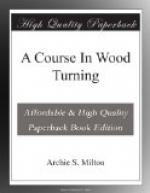Place the chisel on the rest, with the cutting edge above the cylinder and the lower grind tangent to it. Draw the chisel back and raise the handle to bring the heel of the chisel in contact with the cylinder at the line indicating the center of the bead. The chisel is then moved to the right (if cutting the right side of the bead); at the same time the chisel is continually tipped to keep the lower grind tangent to the revolving cylinder and also to the bead at the point of contact. Fig. 13. This cut is continued until the bottom of the bead is reached. It is well in turning a series of beads to work the same side of all before reversing to the other side.
Note:—The same principles employed in this exercise are also used in working out long convex curves such as are found in chisel handles, mallet handles, etc. The only exception is that in most cases the point of contact need not be the heel of the chisel but higher up as in ordinary straight work.
A-I—7-a—Combination Cuts
These exercises are so designed as to include one or more of each of the foregoing cuts. The student here is given an opportunity of combining these cuts into one finished product.
[Illustration: Fig. 13.]
An analysis of the exercise chosen should be made to determine which of the various cuts should be made first, second, etc., in order to produce the exercise in the shortest time and with the least amount of tool manipulation.
After the student has mastered these cuts with a certain degree of skill and accuracy, he is ready to apply them in working out various models in Section II.
A-II—1-a. Chisel Handles
At this point it is well to state that the small end of all work should be turned at the dead center. In the case of chisel handles the socket or ferrule end is at the dead center where the stock can safely be cut away to permit the fitting of the ferrule or the socket.
After the stock is turned to a cylinder of the largest dimension desired, the taper, for the socket chisel, should be turned first and fitted to the chisel in which it is to be used. Then the rest of the handle is worked out. Ferrules should also be fitted in the same manner. A drive fit should be used for all ferrules.
A-II—2 and 3. Mallets and Gavels
The biggest source of trouble in these models is getting the handles to fit true. This is caused by not getting the hole in the head straight.
Turn the head to a cylinder 3/16” larger than the finished dimension. Then bore the hole perpendicular to the axis as near as possible, either by leaving it between the lathe centers or by placing it in a vise. The handle is then fitted into the head. A snug fit is necessary. If one side “hangs” or is lower than the other the centers are moved sufficiently to correct it. The head is then turned to exact size and finished.




